Rubber ficus: features, varieties and growing rules
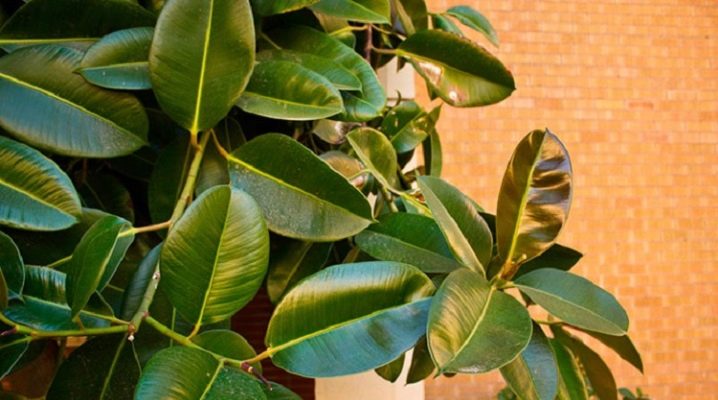
The rubber-bearing ficus, an interesting specimen of the mulberry family, has gained immense popularity among indoor plants. It is distributed almost all over the world, has many shapes and shades. We will consider the features of this amazing plant, its variety, as well as the rules for growing in the article.
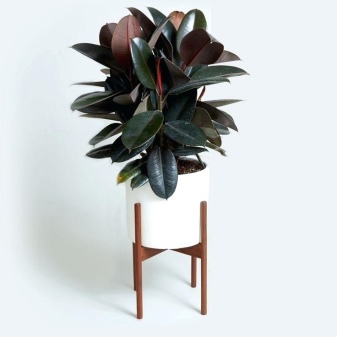

Peculiarities
On average, the size of rubber ficus in the wild reaches 30 meters, but there are exhibits that grow up to 60 meters. Its diameter is 2 meters or more. For most of its life, the ficus grows and forms, and then a phase of gradual extinction begins. Initially, the plant is a tree with one trunk. As the trunk grows, branches appear. Aerial roots are formed from many branches, they descend to the soil and make their way into it, providing additional nutrition.
The leaves on the branch are arranged alternately. The foliage takes the form of a pointed oval. The size of the leaves can be up to 30 cm long and up to 15 cm wide. The color of the outer side of the leaves is glossy and can be of different colors.
But the inner side is matte, pale green.
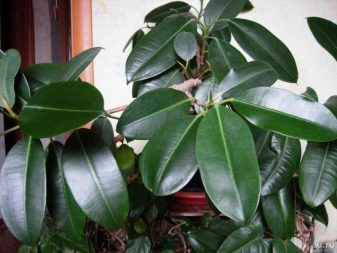
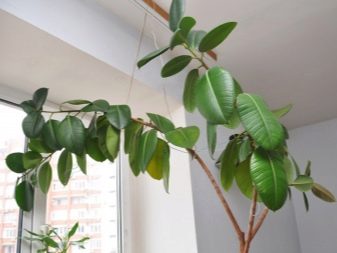
A ficus that grows at home will need support, otherwise the plant may break. Flowers and fruits are exceptionally large trees. The plant is very easy to grow from seed.
Is it poisonous?
In the stem and leaves of the plant, there is a white liquid that contains isoprene. If a wound appears, then it must be treated with a mixture of paraffin and oil, then wrapped with a bandage. Crushed activated carbon can also be added.
With all accuracy, we can say that the plant is poisonous. There is a white thick sap all over the flower, which is poisonous. In the case when the juice gets on the skin, eyes or stomach, symptoms such as rash, hives are observed. And irritation and burning also appear.
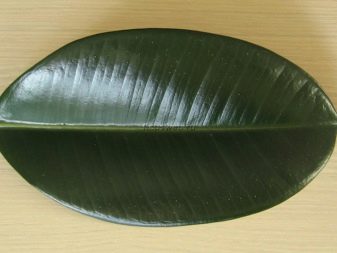

If the juice gets on the mucous membrane of the eyes, then a burn and even deterioration of vision is possible. If vision begins to deteriorate rapidly, then urgent hospitalization will be required. A burn can also form on the skin, but to prevent this, it must be washed with running water and soap. If the juice suddenly gets into the stomach, signs of acute poisoning may appear. They are manifested by diarrhea, nausea, migraine, convulsions. Therefore, it is urgent to rinse the stomach, drink an absorbent and call a doctor.
In rare, especially severe cases, the owner of such a flower may fall into a coma. This flower is a great threat to children, women in position and pets. If someone in the house suffers from severe allergies, including asthma, then you should not start a ficus.
This will prevent the onset of an attack of the disease.



However, rubber ficus also has useful properties. It actively cleans the air from poisonous gases, converting them into hydrocarbons. Medicines made from foliage and sap treat diseases of the breast, and it is also used for cancer, benign tumors. Even with its juice, you can do dressings for joint diseases and hemorrhoids.
The ancient Indians believed that the plant absorbs all negative energy. In addition, it was believed that the ficus will help the child appear, which the future parents have been waiting for so long.


Varieties
The rubbery ficus has many varieties. Let's consider the most common ones.
Belize
This variety has a variegated color, it has an interesting combination of colors (in the description there are green, white, pink, emerald, pistachio and beige colors), and this distinguishes it from others. This variety was created in greenhouse conditions. The foliage of this flower is quite large (up to 23 cm long and up to 13 cm wide).
Rachis protrudes from the outside and inside, and is colored purple.
The plant is decorative, very elastic and needs constant special care.


"Black Prince"
This variety of ficus is distinguished by cherry-colored foliage. Doesn't need special care. This ficus is the most traditional cultivated flower. It is grown not only at home, but also in arboretums.

"Abidjan"
This variety is distinguished by scarlet foliage, the flower does not need special care. And it got its name in honor of a city in Africa. This variety is one of the most common plants. Such a flower will only bring you joy. The magnificent foliage is glossy on the outside. It is easy to care for and grows quickly. The leaves reach a length of 25 cm and a width of 17 cm. And they have an emerald color, the rachis on the outside of the leaf is pistachio color, and on the inside - scarlet. The stem on which the leaf is located is emerald green. Over time, the flower may start branching. Initially, this type of plant appeared in Asia. In this regard, the flower loves warmth, and does not tolerate cold. But also this species has adapted well to our climate and grows well in apartments.
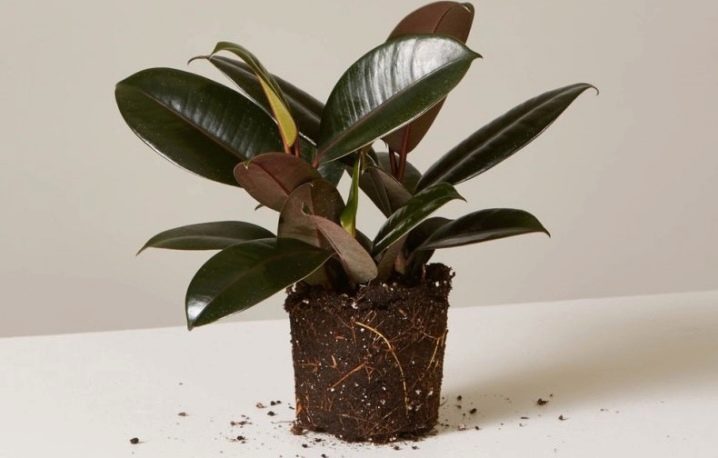
In what conditions does it grow?
A large number of species of rubber-bearing ficus grows in the tropics. The homeland of this plant is India and southern Indonesia. Under natural conditions, the plant becomes large in diameter from 6 to 10 meters. A ficus that grows in natural conditions is significantly different from a home one.
Some species have adapted well to our climate. Especially rubbery - this is the most common type in apartments. By trimming and shaping the crown, the plant takes on a presentable appearance and does not take up much space.
Therefore, there are no problems with keeping it in the apartment. Ficus can adapt to any living environment.


Home care
Now let's figure out how to properly look after such a flower. There are no difficulties in caring for him, you just have to follow some rules. Like many flowers, ficus is thermophilic, but the bright sun is not good for it. And also do not put it in the shade, as its growth will noticeably slow down, and soon the leaves will turn yellow and fall off. The optimum temperature during the warm period is from 20 to 25 degrees Celsius, and the plant can also tolerate a higher temperature for a short time. In the winter period, the temperature should not drop below +15 degrees.
It is necessary to water the flower when the top layer of the earth dries up. Watering in the warm season is necessary daily, in extreme cases every other day, but in winter it is enough once: the colder, the less often you need to water. The main thing is that the water does not stagnate, all the water that has accumulated in the pan must be immediately drained. In the event that you overdo it with watering, foliage may fall off. The air humidity can be adjusted with a spray bottle.
And you also need to wipe the foliage with a damp cloth once every couple of weeks.


Ficus can be watered from the shower no more than once a month, covering the soil with a plastic bag. In cold weather, you should not spray the flower from a spray bottle, but simply walk over the foliage with a damp cloth and remove it as far as possible from the batteries. In the spring, for better growth, the flower must be fertilized with the necessary means, where nitrogen is present. The main thing is that fertilizer does not fall on foliage and sprouts. If you like to make the foliage shine as much as possible, you should not use products that contain chemistry, but you can resort, for example, to using beer, as long as it is alcohol-free.

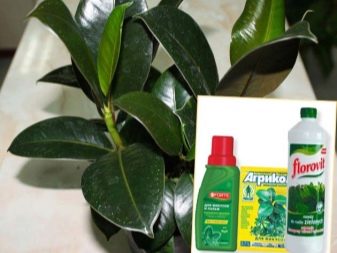
Various varieties of ficus also require special care. Consider how to properly care for the most popular varieties.
Belize
This species and all other bright species of ficuses simply need bright light to maintain color and coloration. The most suitable place with the best lighting would be by a window that faces the sunny (south side). And also in the summer they must be exposed to the air and protected from the sun at noon. Pay special attention that rather cool rooms, drafts are strictly prohibited. Therefore, in winter it is necessary to keep this variety at home.
Suitable soil for ficus is loose, pH neutral and beneficial. You can use soil designed specifically for ficus, and also mixed greenhouse soil and deciduous humus with the addition of coarse sand. You can also add peat soil.
All in equal quantity.

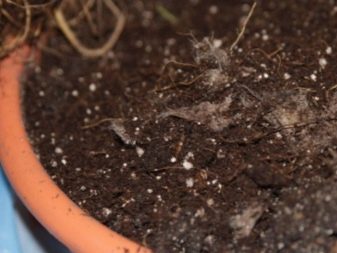
"Abidjan"
This type of ficus is very easy to care for. The main thing is to find a suitable place. It should be light, without exposure to sunlight. If it is in a dark room, it will grow poorly. There is nothing difficult in the maintenance of such a plant, the main thing is to follow certain requirements.
The main one is that you should not immediately transplant the ficus after purchase, it must get used to the new conditions. You can transplant only after 3 weeks. Pay attention, when the ficus gets into conditions unknown to it, it can throw off the leaves. No need to worry about this, so he adapts to a new place. Over time, the plant will adapt and recover, starting to grow rapidly.
This ficus loves medium watering. The earth should not be allowed to dry. Pour with warm water, which is infused or filtered water. And also it is necessary to spray from a spray bottle and wipe the foliage with a wet rag. In the summer, watering should be done a couple of times every 7 days. And in winter - much less often.



"Black Prince"
When purchasing, be sure to understand what kind, because very often in stores the species are confused.
In indoor conditions, the plant loses the ability to dynamically branch, although with the right content it can live up to 40 years or more. Pour with settled or filtered water at room temperature. We water in the event that the top layer of the soil is dry. Please note that with excessive watering, root decay may occur. And this can lead to the loss of the plant.
The rubber-bearing ficus almost does not bloom in various rooms at any time of the year.
Occasionally, an oval yellowish fruit of small size may appear.
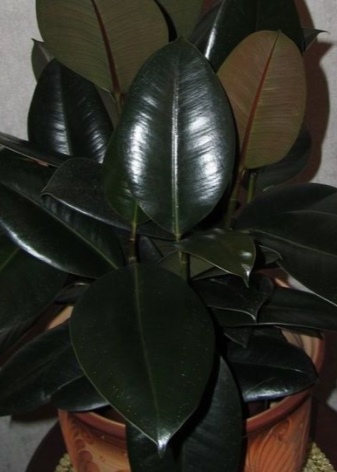

Trimming and shaping
This is a mandatory procedure for ficus. It is necessary to maintain the required height, as well as to form the crown in the spring. During this period, the plant grows intensively, and at this time it is easier to tolerate pruning or pinching. During this process, do not forget that the plant has sap, which is poisonous and can cause severe allergies.
When the flower grows to its optimum height, it is then possible to pinch the top. If the plant has exceeded the required height, first you need to cut 5-7 cm above the desired leaf, and only then pinch. Such a procedure will help to stop development and create a beautiful crown. But before you prune the plant, you need to disinfect a knife or garden shears. After you have finished trimming, the tool will need to be processed from the juice. When the top is trimmed off, the lateral shoots awaken, which will ensure uniform foliage growth.
In winter and spring, pruning is not recommended, because the flower will lose a lot of irreplaceable substances.
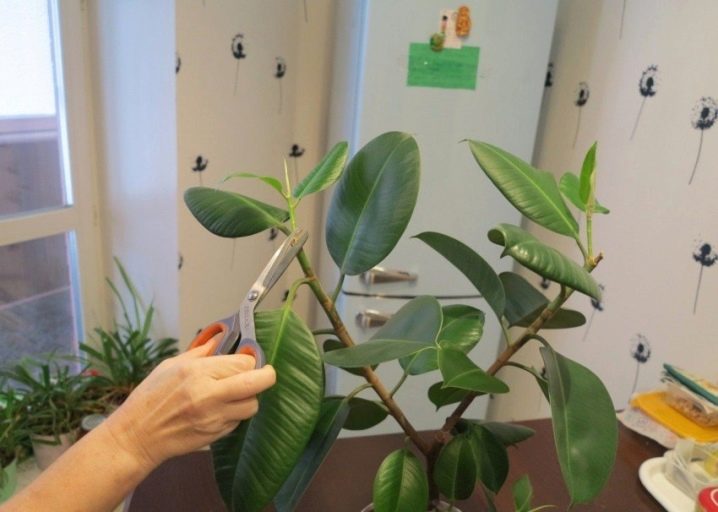
Pruning is done in order to keep the ficus in the right and suitable sizes for you, as well as to form a lush crown, because the foliage falls off after a certain time.
Let's figure out how to properly prune a rubber-bearing ficus.
If you want to activate the growth of lateral stems, then it is worth cutting off 5-6 adjacent nodes. If you just cut off the top, then it will not branch, at most one upper bud will germinate.
If the plant has grown quickly, then you can cut off the top and transplant it into a pot. After the planted tip has grown and reached a large size, the procedure can be repeated. Pruning can only be done in early spring, because the top will grow, and not the side shoots. The main thing is to cut the plant with a processed tool. The remaining juice is removed with water. Treat the cut site with paraffin or crushed activated carbon. If the ficus is not trimmed, it will acquire large sizes - several meters.
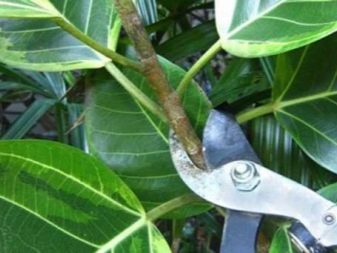

Pruning will help stun growth, promote lush crown growth, and cause the flower to branch. Each grower can easily choose the ideal size of rubber ficus for himself.
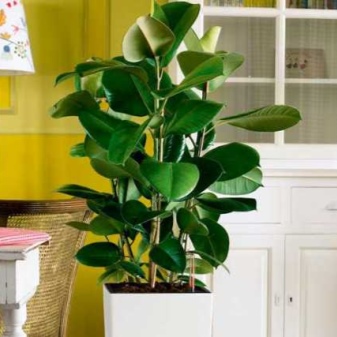

There are 3 options for the formation of a crown in an adult ficus.
Trimming, which involves removing not only the tops, but also adjacent nodes located nearby. If the trunk is secured in a bent state, this will facilitate the replacement of the lateral shoots with the predominant ones. It is also possible to make a puncture 1/3 deep into the trunk with a disinfected thick needle for the formation of new shoots. If you want multiple new branches, you can make a couple of punctures. Do not forget that sprouts will sprout from the lowest one. Therefore, it is worth holding this event from above.
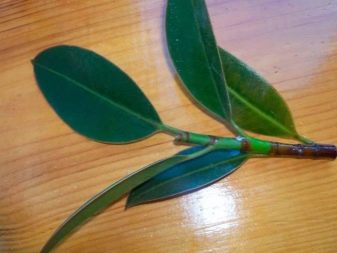
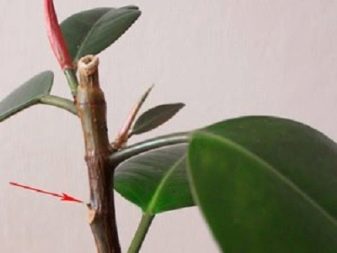
But it is also possible to form foliage without pruning.
You should not immediately take up the tool and cut off the ficus. First you need to think about whether this is necessary. There is another option for the formation of the crown, it implies a change in the direction of the shoots and their fixation. This type of formation will reduce damage to the plant. And it can be applied at any time of the year. After a certain time, after the branches have taken the correct position, the mount is removed.
At the time when you prune the plant, you need to take into account its age. This action will do less harm to a young plant. You must be very careful with an adult ficus, since its shoots are almost inelastic, and such an operation can injure them.
The requirements described below apply to a ficus that has only one trunk.
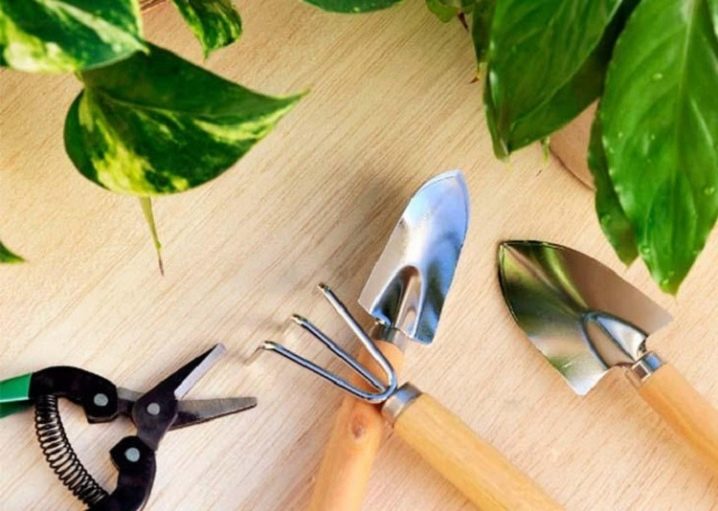
It is worth pruning the plant when its height has reached 70 cm. It will be necessary to cut off the top. Subsequently, the formation of lateral shoots will begin. And you can also plant the cut off top to the ficus, from which this part was cut off. This solution will give the plant an interesting shape.
In rare cases, it is necessary to form a crown in low ficuses. Cutting is not recommended here, it is better to use pinching of the top. It is worth pinching very carefully. Only when using this method will the plant have one stem.

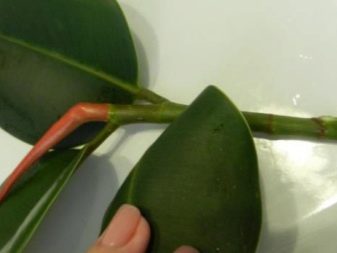
Another method can be used to stimulate the emergence of new lateral shoots. To do this, you just need to bend the top and fix it in this position. After new shoots begin to appear, the tip returns to its usual position.
And you can also cut a small twig with a straight cut. But a large branch must be cut at an angle. And do not forget that cutting and puncturing must be done exclusively with disinfected devices that have a sharpened blade. You can process the tool with medical alcohol, but if it is not there, you can heat it on fire.
Do not forget that after the ficus has been cut off, juice will appear at the place where the cut was, it should be treated with paraffin or activated carbon.And remove the juice from the instrument with a damp cloth.
After a month after pruning, it is necessary to feed the plant.
Please note that more space will be needed for the ficus, and you will have to transplant it into a larger pot.

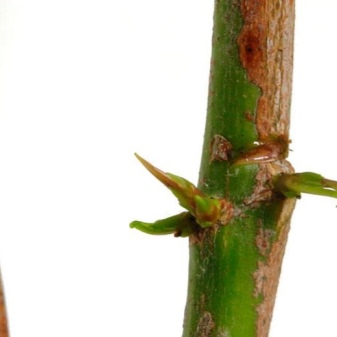
Let's consider how to form a beautiful crown.
With a strong desire, even a beginner in this business will be able to give the elastic ficus a unique shape. To do this, a wide pot will come in handy; several plants will need to be transplanted into it. Young flowers with well-developed sprouts are best suited for this. Their growth should not exceed 15 cm. And it is also necessary to cut off all lateral processes. You also need to pay attention to the trunk - it needs to be regularly given a certain shape.
The main thing is not to forget that the branches are woven without pulling them too much, there should be space between them, since over time the branches will thicken. If you plant several young plants in one pot, you can get a spiral. And if you plant three plants, you can get a scythe. Not all branches are allowed to weave. It is possible only if they have grown to a certain size (13-15 cm).
It may take some more time to create an additional curl, since it is added as the ficus grows.

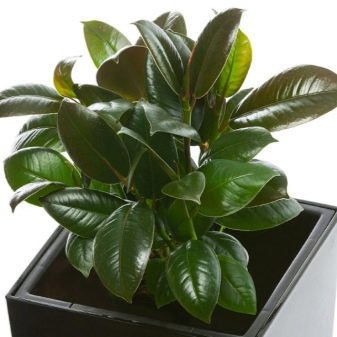
During pruning of rubber ficus, it is imperative to take measures so that the braid does not unravel in any way. To do this, it is worth doing the dressing of the plant trunks. For this, soft threads are used. The most suitable will be woolen or terry. This dressing is carried out every 2 months. In some situations, the installation of supports may be required for the correct growth of rubbery ficus. In this case, without any problems, you can make sure that the rubbery ficus (elastica) will acquire an impressive, interesting and unique look.
The process of pruning rubbery ficus is not a difficult task. The main thing is to follow exactly and fulfill all the necessary requirements. And you should also be very careful when working with juice, as it is poisonous.
In order to avoid negative reactions, it is worth working with a flower exclusively in rubber gloves.


Transfer
Now let's figure out how to properly transplant.
A young flower should be transplanted only once a year, but an adult plant can be transplanted once every few years. When replanting a plant, you need to be extremely careful not to harm the root system. It is better to make the soil for the rubbery ficus yourself. For adult flowers, a mixture of several types of soil, such as deciduous and coniferous humus, greenhouse soil and coarse sand, is best suited. All in equal quantity.
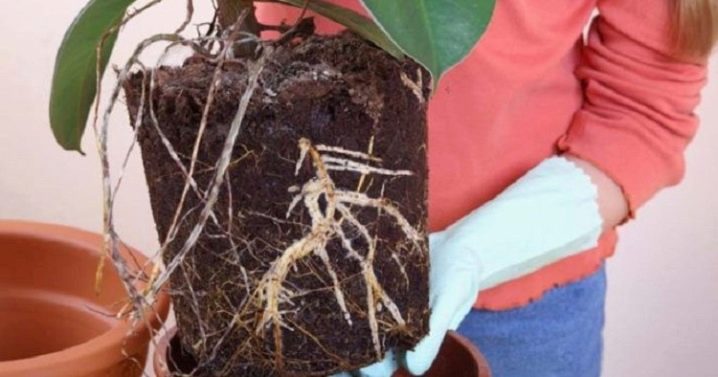
The best time to transplant is spring and summer. In the event that the plant is purchased in the fall, you should not immediately transplant, but it is better to move it to spring or summer, because it will be difficult for the ficus to adapt to another room.
It is worth replanting the plant only in certain cases, when the flower has become large, and the pot has become small for it, and when the soil does not hold water. This means that the soil is depleted. And also the transplant is carried out if the root system has filled the entire pot. The plant responds well to transplanting into a larger pot than the previous one, and begins to develop more vigorously.
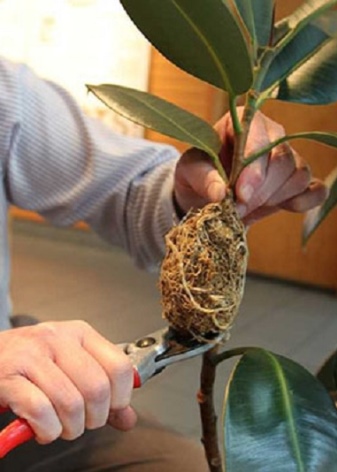
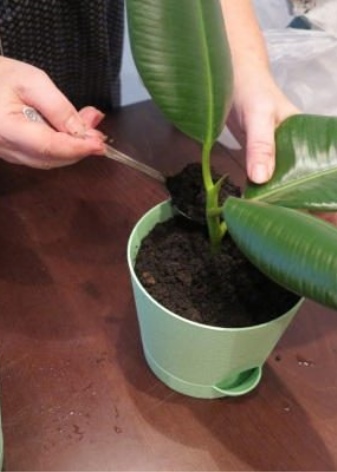
The new pot should not be taken much more than the past. Because if you take several times more, the root system will begin to actively grow, and this will affect the growth of the plant itself. Drainage from pebbles, coal and bricks is laid in it, minerals are also added. All this is laid out 3 cm thick. And only then comes a mixture of soil and sand, all in equal quantities.
The soil can be purchased at the store or you can get it yourself. The plant is placed in a pot in the center and covered with soil. After the soil is backfilled, it is compressed and watered. During the month, the ficus adapts to other conditions.During this time, he can throw off the leaves, and only then begin to grow. Before planting or replanting a plant, you first need to prepare the soil.
You can buy it at any flower shop.

Please note that if you plant or transplant ficus elastic in soil with an increased acidity level, the plant will not survive. Alkaline balance should not exceed 7 ph, but also not lower than 5 ph. The transplant is carried out strictly in the spring.
For tips on the care and reproduction of rubber ficus, see the following video

























The comment was sent successfully.